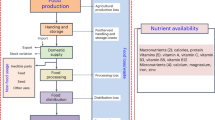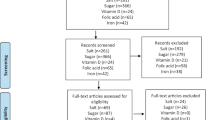Abstract
Background:
In Europe, micronutrient recommendations have been established by (inter)national committees of experts and are used by public health-policy decision makers to monitor and assess the adequacy of the diets of population groups. Current micronutrient recommendations are, however, heterogeneous, whereas the scientific basis for this is not obvious. Alignment of setting micronutrient recommendations is necessary to improve the transparency of the process, the objectivity and reliability of recommendations that are derived by diverse regional and (inter)national bodies.
Objective:
This call for alignment of micronutrient recommendations is a direct result of the current sociopolitical climate in Europe and uncovers the need for an institutional architecture. There is a need for evidence-based policy making, transparent decision making, stakeholder involvement and alignment of policies across Europe.
Results:
In this paper, we propose a General Framework that describes the process leading from assessing nutritional requirements to policy applications, based on evidence from science, stakeholder interests and the sociopolitical context. The framework envisions the derivation of nutrient recommendations as scientific methodology, embedded in a policy-making process that also includes consumer issues, and acknowledges the influences of the wider sociopolitical context by distinguishing the principal components of the framework: (a) defining the nutrient requirements for health, (b) setting nutrient recommendations, (c) policy options and (d) policy applications.
Conclusion:
The General Framework can serve as a basis for a systematic and transparent approach to the development and review of micronutrient requirements in Europe, as well as the decision making of scientific advisory bodies, policy makers and stakeholders involved in this process of assessing, developing and translating these recommendations into public health nutrition policy.
This is a preview of subscription content, access via your institution
Access options
Subscribe to this journal
Receive 12 print issues and online access
$259.00 per year
only $21.58 per issue
Buy this article
- Purchase on Springer Link
- Instant access to full article PDF
Prices may be subject to local taxes which are calculated during checkout


Similar content being viewed by others
References
Ashwell M, Lambert JP, Alles MS, Branca F, Bucchini L, Brzozowska A, et al., EURRECA Network (2008). How we will produce the evidence-based EURRECA toolkit to support nutrition and food policy. Eur J Nutr 47 (Suppl 1), 2–16.
Commission of the European Communities (1993). Nutrient and energy intakes for the European Community. Reports of the Scientific Committee for Food. Thirty first series.
Department of Health (2000). Report on Health and Social Subjects. No. 50 HMSO: London.
Doets EL, de Wit LS, Dhonukshe-Rutten RA, Cavelaars AE, Raats MM, Timotijevic L et al. (2008). Current micronutrient recommendations in Europe: towards understanding their differences and similarities. Eur J Nutr 47 (Suppl 1), S17–S40.
EFSA Panel on Dietetic Products, Nutrition, and Allergies (NDA) (2010). Scientific Opinion on principles for deriving and applying dietary reference values. EFSA J 8, 1458.
EFSA (2009). Transparency in risk assessment—scientific aspects. Guidance of the Scientific Commmittee on Transparency in the Scientific Aspects of Risk Assessments carried out by EFSA. Part 2: General Principles. Question No. EFSA-Q-050Ba).
European Commission (2000). Science, Society and the Citizen in Europe. The Commission Working Document. COM 2000.
European Commission (2001). European Governance: A White Paper. COM 2001 428 final, 25 July. [http://eur-lex.europa.eu/LexUriServ/site/en/com/2001/com2001_0428en01.pdf].
European Commission (2002). Communication from the Commission: Towards a Reinforced Culture of Consultation and Dialogue—general principles and minimum standards of consultation of interested parties by the Commission. COM 2002 704, final, 11 December.
European Commission (2006). Green Paper: European Transparency Initiative. COM 2006 194, final, 3 May.
Fairweather-Tait SJ (2008). Biomarkers of micronutrient status. Br J Nutr 99, S1–S9.
Garza C, Pelletier DL (2007). Dietary guidelines past, present, and future. In: Kennedy E, Deckelbaum R (eds). Nation's Nutrition. ILSI Press: Washington, DC, P. 205.
Hautvast JG, Baya C, Amorim Cruz JA, de Backer GG, Ducimetière P, Durnin JV et al. (1989). Recommended dietary allowances for Europe. Lancet 2, 1220.
Hooper L, Ashton K, Harvey LJ, Decsi T, Fairweather-Tait SJ (2009). Assessing potential biomarkers of micronutrient status by using a systematic review methodology: methods. Am J Clin Nutr 89, S1953–S1959.
King JC, Garza C (2007). (Guest eds.): International harmonization of approaches for developing nutrient-based dietary standards. The United Nations University. Food and Nutrition Bulletin 28 (Suppl 1), S3–S153.
King JC, Vorster HH, Tomé DG (2007). Nutrient intake values (NIVs): a recommended terminology and framework for the derivation of values. Food Nutr Bull 28, S16–S26.
Pavlovic M, Prentice A, Thorsdottir I, Wolfram G, Branca F (2007). Challenges in harmonizing energy and nutrient recommendations in Europe. Ann Nutr Metab 51, p. 108–114.
Pijls L, Ashwell M, Lambert J (2009). EURRECA—A network of excellence to align European micronutrient recommendations. Food Chem 113, 748–753.
Prentice A, Branca F, Decsi T, Fleischer Michaelsen K, Fletcher Reg J, Guesry P et al. (2004). Energy and nutrient dietary reference values for children in Europe: methodological approaches and current nutritional recommendations. Br J Nutr 92 (Suppl 2), S83–S146.
Serra-Majem L (2009). Dietary assessment of micronutrient intakes: a European perspective. Br J Nutr 101, S2–S5.
Taylor CL (2008). Framework for DRI Development: Components ‘Known’ and Components ‘To Be Explored’, background paper. Scholar, Food and Nutrition Board, Institute of Medicine National Academies: Washington, DC.
Timotijevic L, Raats MM, Barnett J, Brown K, Shepherd R, Fernandez L et al. (2010). From micronutrient recommendations to policy: consumer and stakeholder involvement. Eur J Clin Nutr 64 (Suppl 2), S31–S37.
Acknowledgements
The work reported herein has been carried out within the EURRECA Network of Excellence (http://www.eurreca.org), which is financially supported by the Commission of the European Communities, specific Research, Technology and Development (RTD) Programme Quality of Life and Management of Living Resources, within the Sixth Framework Programme, project no. FP6 036196-2. This report does not necessarily reflect the Commission's views or its future policy in this area. We acknowledge Liesbeth de Wit, Anna Brzozowska, Trudy Wijnhoven, Garden Tabacchi, Torunn Holm Totland, Lene Frost Andersen, Jiri Ruprich and key informants from the UNU/SCN Network for Capacity Development in Nutrition in Central and Eastern Europe and from other countries listed above for their contribution towards completing the questionnaire sent out by Eurreca. We are grateful to all partners of the EURRECA network (specifically to the partners of RA1.4 Current Recommendations) for the feedback on earlier drafts of the general framework and this report. This enabled us to develop our views and ideas and give direction to the future work of EURRECA.
Author information
Authors and Affiliations
Corresponding author
Ethics declarations
Competing interests
The authors declared no conflict of interest.
Additional information
Contributors: GT performed part of the work under a short-term contract for WHO Europe.
Rights and permissions
About this article
Cite this article
Dhonukshe-Rutten, R., Timotijevic, L., Cavelaars, A. et al. European micronutrient recommendations aligned: a general framework developed by EURRECA. Eur J Clin Nutr 64 (Suppl 2), S2–S10 (2010). https://doi.org/10.1038/ejcn.2010.55
Published:
Issue Date:
DOI: https://doi.org/10.1038/ejcn.2010.55
Keywords
This article is cited by
-
A Systematic Review on Micronutrient Intake Adequacy in Adult Minority Populations Residing in Europe: The Need for Action
Journal of Immigrant and Minority Health (2014)
-
Prioritizing micronutrients for the purpose of reviewing their requirements: a protocol developed by EURRECA
European Journal of Clinical Nutrition (2010)
-
Nutri-RecQuest: a web-based search engine on current micronutrient recommendations
European Journal of Clinical Nutrition (2010)
-
EURRECA: development of tools to improve the alignment of micronutrient recommendations
European Journal of Clinical Nutrition (2010)



